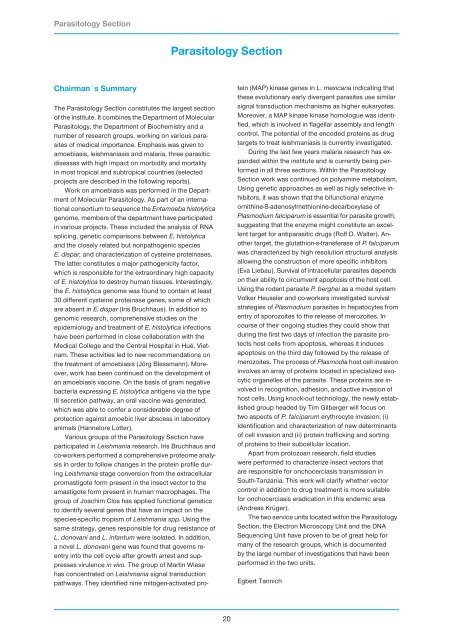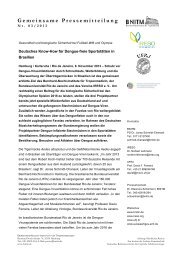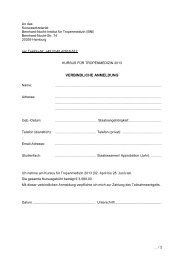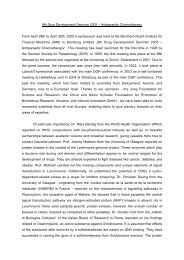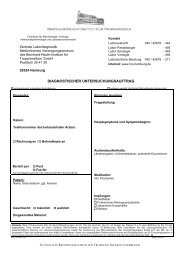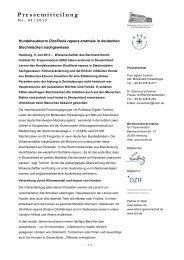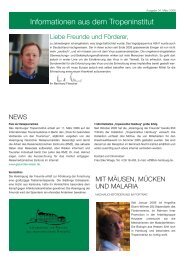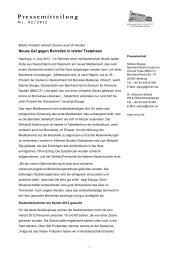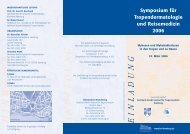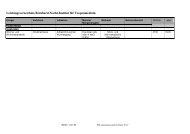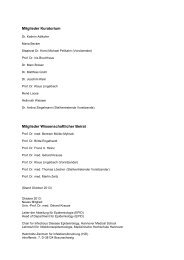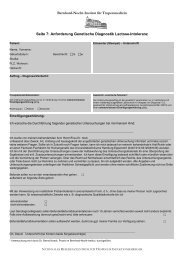Research Group Heussler (Malaria I) - Bernhard-Nocht-Institut für ...
Research Group Heussler (Malaria I) - Bernhard-Nocht-Institut für ...
Research Group Heussler (Malaria I) - Bernhard-Nocht-Institut für ...
You also want an ePaper? Increase the reach of your titles
YUMPU automatically turns print PDFs into web optimized ePapers that Google loves.
Parasitology Section<br />
Chairman´s Summary<br />
The Parasitology Section constitutes the largest section<br />
of the institute. It combines the Department of Molecular<br />
Parasitology, the Department of Biochemistry and a<br />
number of research groups, working on various parasites<br />
of medical importance. Emphasis was given to<br />
amoebiasis, leishmaniasis and malaria, three parasitic<br />
diseases with high impact on morbidity and mortality<br />
in most tropical and subtropical countries (selected<br />
projects are described in the following reports).<br />
Work on amoebiasis was performed in the Department<br />
of Molecular Parasitology. As part of an international<br />
consortium to sequence the Entamoeba histolytica<br />
genome, members of the department have participated<br />
in various projects. These included the analysis of RNA<br />
splicing, genetic comparisons between E. histolytica<br />
and the closely related but nonpathogenic species<br />
E. dispar, and characterization of cysteine proteinases.<br />
The latter constitutes a major pathogenicity factor,<br />
which is responsible for the extraordinary high capacity<br />
of E. histolytica to destroy human tissues. Interestingly,<br />
the E. histolytica genome was found to contain at least<br />
30 different cysteine proteinase genes, some of which<br />
are absent in E. dispar (Iris Bruchhaus). In addition to<br />
genomic research, comprehensive studies on the<br />
epidemiology and treatment of E. histolytica infections<br />
have been performed in close collaboration with the<br />
Medical College and the Central Hospital in Hué, Vietnam.<br />
These activities led to new recommendations on<br />
the treatment of amoebiasis (Jörg Blessmann). Moreover,<br />
work has been continued on the development of<br />
an amoebiasis vaccine. On the basis of gram negative<br />
bacteria expressing E. histolytica antigens via the type<br />
III secretion pathway, an oral vaccine was generated,<br />
which was able to confer a considerable degree of<br />
protection against amoebic liver abscess in laboratory<br />
animals (Hannelore Lotter).<br />
Various groups of the Parasitology Section have<br />
participated in Leishmania research. Iris Bruchhaus and<br />
co-workers performed a comprehensive proteome analysis<br />
in order to follow changes in the protein profile during<br />
Leishmania stage conversion from the extracellular<br />
promastigote form present in the insect vector to the<br />
amastigote form present in human macrophages. The<br />
group of Joachim Clos has applied functional genetics<br />
to identify several genes that have an impact on the<br />
species-specific tropism of Leishmania spp. Using the<br />
same strategy, genes responsible for drug resistance of<br />
L. donovani and L. infantum were isolated. In addition,<br />
a novel L. donovani gene was found that governs reentry<br />
into the cell cycle after growth arrest and suppresses<br />
virulence in vivo. The group of Martin Wiese<br />
has concentrated on Leishmania signal transduction<br />
pathways. They identified nine mitogen-activated pro-<br />
Parasitology Section<br />
20<br />
tein (MAP) kinase genes in L. mexicana indicating that<br />
these evolutionary early divergent parasites use similar<br />
signal transduction mechanisms as higher eukaryotes.<br />
Moreover, a MAP kinase kinase homologue was identified,<br />
which is involved in flagellar assembly and length<br />
control. The potential of the encoded proteins as drug<br />
targets to treat leishmaniasis is currently investigated.<br />
During the last few years malaria research has expanded<br />
within the institute and is currently being performed<br />
in all three sections. Within the Parasitology<br />
Section work was continued on polyamine metabolism.<br />
Using genetic approaches as well as higly selective inhibitors,<br />
it was shown that the bifunctional enzyme<br />
ornithine-S-adenosylmethionine-decarboxylase of<br />
Plasmodium falciparum is essential for parasite growth,<br />
suggesting that the enzyme might constitute an excellent<br />
target for antiparasitic drugs (Rolf D. Walter). Another<br />
target, the glutathion-s-transferase of P. falciparum<br />
was characterized by high resolution structural analysis<br />
allowing the construction of more specific inhibitors<br />
(Eva Liebau). Survival of intracellular parasites depends<br />
on their ability to circumvent apoptosis of the host cell.<br />
Using the rodent parasite P. berghei as a model system<br />
Volker <strong>Heussler</strong> and co-workers investigated survival<br />
strategies of Plasmodium parasites in hepatocytes from<br />
entry of sporozoites to the release of merozoites. In<br />
course of their ongoing studies they could show that<br />
during the first two days of infection the parasite protects<br />
host cells from apoptosis, whereas it induces<br />
apoptosis on the third day followed by the release of<br />
merozoites. The process of Plasmodia host cell invasion<br />
involves an array of proteins located in specialized exocytic<br />
organelles of the parasite. These proteins are involved<br />
in recognition, adhesion, and active invasion of<br />
host cells. Using knock-out technology, the newly established<br />
group headed by Tim Gilberger will focus on<br />
two aspects of P. falciparum erythrocyte invasion: (i)<br />
Identification and characterization of new determinants<br />
of cell invasion and (ii) protein trafficking and sorting<br />
of proteins to their subcellular location.<br />
Apart from protozoan research, field studies<br />
were performed to characterize insect vectors that<br />
are responsible for onchocerciasis transmission in<br />
South-Tanzania. This work will clarify whether vector<br />
control in addition to drug treatment is more suitable<br />
for onchocerciasis eradication in this endemic area<br />
(Andreas Krüger).<br />
The two service units located within the Parasitology<br />
Section, the Electron Microscopy Unit and the DNA<br />
Sequencing Unit have proven to be of great help for<br />
many of the research groups, which is documented<br />
by the large number of investigations that have been<br />
performed in the two units.<br />
Egbert Tannich


